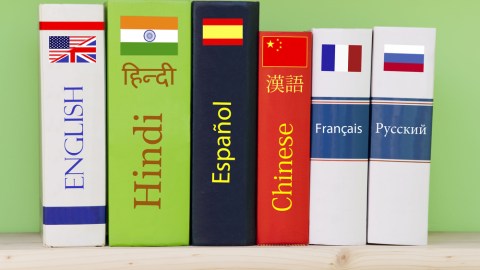How Cartoons Help You Learn Another Language

Nation of polyglots
The complexity of slovenščina (the Slovenian language) isn’t the main reason few try to learn it; the real reason nobody tries to learn it is that Slovenians usually speak your native language.
Within Europe, Slovenians come in third in speaking a foreign language. Europeans proclaim they’re all polyglots, but 44 percent of EU citizens can only speak one language.
In contrast, it’s nearly impossible to find a monolingual person in Slovenia. While 28 percent of Europeans speak at least three languages, a whopping 71 percent of Slovenians are at least trilingual. Only the Netherlands (75%) and Luxembourg (92%) have higher percentages.
In Eastern Europe, I often had to ask 10 random people to find one good English speaker. In Slovenia, I had to ask 10 people to find one person who did not speak English. They also normally spoke either Croatian, Italian, or German (and many spoke all three of them).
Several Slovenians I met also understood Spanish, thanks to the telenovelas. Sanela Kadić, a Slovenian who is fluent in six languages, told me, “Slovenians always make the effort to learn other people’s languages, so nobody bothers to learn Slovenian.”
That’s the price you pay for being a nation of just two million surrounded by much larger linguistic regions (Italy, Germany, South Slavic). Nevertheless, Slovenians are rightfully frustrated that some immigrants live in Slovenia for years and never learn Slovenian properly. Since Slovenians are the masters of learning many languages, they can teach the world how they do it.
How to learn a language quickly
With seven in 10 Slovenians being trilingual, they know all the tricks to learn any language fast. They shared their tips with me.
First, it’s a myth that kids are better at learning languages than adults. If an adult spends as much time as a child does to learn Latvian, he’ll know it just as well as a child. The only reason children seem to learn faster than adults is that they spend more time studying.
Still, a child does have one advantage over an adult: pronunciation. Although an eight-year-old can’t learn Bulgarian any faster than a 40-year-old, the child will be better at speaking it without an accent. Before 14 years old, humans are able to mimic the correct sounds of any language. However, after 14, we begin to lose that ability. That’s why some American immigrants use words that only a Scrabble nut would know, but say them with an accent.
Now that you know you can learn any language, let’s see how Slovenians do it quickly. Andreja Nastasja Terbos, who is fluent in three languages and proficient in three more, offered great advice: do what children do.
- Watch cartoons (which is easy with YouTube)
- Read children’s books and comic books. They all use core vocabulary, basic grammar, and helpful pictures.
- Don’t feel stupid reading Little Red Riding Hood in Hungarian.
- When you read books, don’t discourage yourself by trying to understand everything.
- Favor small dictionaries because they’re easy to carry and have the essential words.
- Improve your vocabulary by associating it with experience—you’re more likely to remember what a mešalnik is if you use one (it’s a blender in Slovenian).
- Listen to music in your desired language, decode the lyrics, and sing along.
- Many children aren’t afraid to make mistakes—neither should you.
If you lack discipline, hire a young tutor. They’re cheap and are unlikely to teach you the traditional (not commonly used) way of saying something. Favor solo learning over group learning.
The Slovenian wife of a Belgian man explained how she helped him become fluent in Slovenian. Write text messages: since you’re limited to 140 characters, it’s good for simple sentences. It’s also good to receive a text message because decoding them is like a mini exercise.
My Slovenian friend, Dušan Trušnovec, is fluent in five languages and advises that if several languages interest you, start with the easiest one. Some believe, “I’m going to learn Japanese, because if I can learn that, I can learn anything.” Yes, that’s true, but you might commit harakiri first.
Pick something that helps you make quick progress. Once you have one or two languages in the bag, learning a fourth or fifth language becomes easier, even if they’re weird ones. That’s how Pope John Paul II learned over a dozen languages.
This strategy works because sometimes seemingly unrelated languages have some random thing in common. For example, in Russian, mokri means wet. Since I speak Spanish, mokri reminds me of the Spanish word mojado, which also means wet.
A Slovenian language teacher advised me, “Learn verbs first. Verbs are the core of any sentence. Without them, a sentence collapses.” Another strategy is to learn the most common words first. Although every language has its own list of common words, use this list as a starting point, and translate these hundred words into the language you want to learn. The best way to learn them is through association. Use the way the word is written or the way it sounds to associate it with something. For example, in Slovenian I recall ljudje (people) by thinking of a bunch of lewd people; or to remember the action iti dol (go down) I visualize an E.T. doll going down.
Anamarija Mišmaš, a Slovenian who understands five languages, helped me by taping a piece of paper on every object in the house and writing what it was. That way, you’ll learn that you enter through the vrata (door) using a ključ (key), then look at yourself in the ogledalo (mirror), put your jacket in the omara (closet), open the hladilnik (fridge) to get a six-pack of pivo (beer) and get drunk on the kavč (couch). Say the words aloud when you see them and eventually add verbs to describe how you interact with the object.
Everyone knows that the best way to learn a language is to live in a country that speaks it, but many who get that chance don’t fully immerse themselves. Instead, they hang out with people who prefer speaking in English. Advice: greet English speakers with a smile, then run away.
However, what if you live in Kentucky and you want to learn Romanian? Thanks to the Internet, it’s easy to find speakers of any language in your community. Believe it or not, there are about 150 Slovenians in North Dakota.
Watch foreign movies with subtitles; if you watch enough of them, you’ll start to understand the language.
When you’re good enough, watch them with subtitles of the language you’re trying to learn—you’ll learn writing and listening simultaneously. Dubbing doesn’t seem like a big deal, but since the average guy spends thousands of hours watching TV and movies every year, subtitling can passively teach us another language.
Although these are all excellent shortcuts to learning a language, ultimately you’ll need to invest several hundred hours to become proficient. There is no magic formula that will let you become fluent in a week. Put in those hours by letting a language infiltrate every part of your life. Then, just like a child, within several months you’ll be speaking some weird language.
Francis Tapon has traveled to 80 countries and spent the last three years traveling to 25 Eastern European countries. He is author of the new book, The Hidden Europe: What Eastern Europeans Can Teach Us. This article is an adapted excerpt from the chapter on Slovenia.





